Introduction:
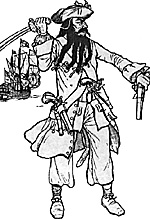 Pirates! is designed for skirmish level raiding ashore. Later Pirates! supplements will include ship to ship pirate combat. Pirates! was influenced by Bob Jones' Piquet and Lance Kizer/Herb Gundt's Brother Against Brother. Combining some elements from each of these rules systems and adding my own bands of attackers approach yielded the following very quick playing pirate raid game. Play test games lasted probably about as long as the real raids. The Pirates inevitably won out against the civilian rabble, but were more than challenged as they faced increasing numbers of armed police/militia and finally the pirates had a very difficult time against real soldiers. This leads me to believe that the rules are realistic. The goal, in any case, is to have fun and I think Pirates! is just that…
Pirates! is designed for skirmish level raiding ashore. Later Pirates! supplements will include ship to ship pirate combat. Pirates! was influenced by Bob Jones' Piquet and Lance Kizer/Herb Gundt's Brother Against Brother. Combining some elements from each of these rules systems and adding my own bands of attackers approach yielded the following very quick playing pirate raid game. Play test games lasted probably about as long as the real raids. The Pirates inevitably won out against the civilian rabble, but were more than challenged as they faced increasing numbers of armed police/militia and finally the pirates had a very difficult time against real soldiers. This leads me to believe that the rules are realistic. The goal, in any case, is to have fun and I think Pirates! is just that…
1. Gaming materials:
- A. Dice: d4, d6, d8, d10, and d12. Multiple d6 and d10 will be helpful.
B. Ruler: inches measure for 25-28mm and centimeters for 15mm.
C. Markers for unloaded (cotton balls) and markers for activated/unactivated individuals (beads/pebbles)
D. deck of playing cards
E. miniatures and scenery
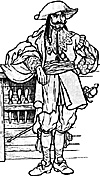 2. Prepare the Deck
2. Prepare the Deck
- A. The scenario determines how many figures are on each side.
B. Pirates are always hearts & diamonds (it is strictly taboo to give a pirate the Ace of spades).
C. Divide the number of figures on a side by two, rounding up (i.e. 21 Pirates yields 11 red suited cards)
D. Pull out card numbers equalling half the total figures on a side, using the lowest cards possible to reach this total (Ace equals one). For example, in the above you have 21 figures, this equals 11 card points. You would pull out the A,A,2,2,3,4 of hearts & diamonds. These cards will activate pirate bands of this size when turned over.
E. A listing is provided at the end of this rules set equating number of figures with correct card numbers and types.
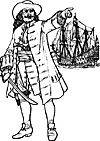 3. Turn Sequence
3. Turn Sequence
- A. After each side's cards are determined, these are combined to form the activation deck. The deck is shuffled before each turn.
- Move
- Fight
- Move & Fight
- Pillage
- Fire
- Reload
B. Two cards are turned over at a time, bands of figures equalling or fewer than the number on the card are activated and can perform one of the actions listed below.
C. Once a band size is determined during the game, that band must remain intact. Example: A group of five civilians moves out of a building. Next turn, a black three is turned up first. The civilian player cannot take three out of this group of five to continue moving.
D. Once a band starts taking losses, then it can be activated by the smaller number cards. Example: A group of five civilians loses one to rifle fire and one who runs away. This group can now be activated by a 3 or higher.
E. Figures can perform one action when activated.
- Actions are:
F. Although figures in a band can perform any action above individually within the group, all figures must be within 6 inches of all other figures in his band.
G. After a band of figures has been activated and performed an action, mark that group. I use small glazed pebbles that you use in the bottom of fish tanks. These don't detract from the table top's appearance, are easy to obtain, and are easy to use.
H. After all the cards in the deck are turned over, reshuffle the deck. Remove your activation markers from the bands, leaving the unloaded cotton (as the rifle/pistol firer is still unloaded).
I. The turn ends.
4. Movement:
- A. Scale: For 25-28mm, 1 inch = 5 feet. For 15mm, 1cm = 5 feet.
B. Distance: Roll 3d10 once per side per turn. Take the top two dice and this is your max move, in inches for any figures moving on that turn. If travelling over broken terrain or uphill, roll only 2d10.
C. Mounted Movement: For those select individuals who are riding horses (captain of the guard, etc.), roll 4d10, and take the highest 3.
D. Group Movement: When a 2 or higher card is turned over and movement is the action, then the number on the card will be equal to or greater than the number of figures moved. Movement of the group of figures is measured from the center of the group. The group can change positions within this movement, but total distance is from the center of the group to the center of the group's new position. ((show overhead example here)). Not all pirates were brave individual fighters, in fact, very few were. That's the reason for the group movement rule using the cards. Pirates moved in small bands of various sizes during a pillaging raid. Not all figures activated as part of a band have to perform the same action. Some may move and some may reload, then catch up on a future turn.
5. Fight:
- A. Defending: The defender will roll 1d6 for each attack rolled against his character.
- The pirate rolls a 6 and the soldier rolls a 1. The soldier is killed.
- The pirate rolls a 5 and the soldier rolls a 1. The soldier figure is immediately turned away from the pirate and moved the inches rolled by that side for that turn. He is now running away and will move during each turn until he is out of the game.
- The pirate rolls a 1 and the soldier rolls a 6. No damage.
B. Attacking:
- (1) The attacker will roll roll anywhere from 1d4 to 1d12, depending on arms used, cover of the defender, and if the character is a personality figure. Dice used are d4, d6, d8, d10, and d12. Example: up one from d8 would be d10.
(2) Arms modifiers:
| Weapon | Base dice |
|---|---|
| Cutlass/Sword | d8 |
| Dagger/hand axe | d6 |
| Club/belaying pin | d6 |
| Hand to hand | d4 |
| Adjustment Types | Modifiers |
|---|---|
| Defender in Cover | down 1 |
| Defender armed (only applies in melee situations) | down 1 |
| Attacking from behind | up 1 |
| Personality Figure (when attacking) | up 1 |
| Personality Figure (when defending) | down 1 |
(3) A figure can only attack once per turn.
C. Taking Hits:
- (1) When the attacker rolls 4 points above the defender (cumulative during the same turn only), then the defending character is killed.
(2) If an attack betters the defender by 3 points, then the defending character considers retreat the better part of valor and disengages from combat for the remainder of the scenario. The figure will either return to the ship if a pirate, or run away if a civilian/soldier. This figure cannot be rallied for the remainder of the scenario.
(3) If an attack only betters the defender by 2 points or less in one turn, when the deck is reshuffled, then all previous hits go away and each figure starts with a clean bill of health.
D. Melee: Once figures are in melee, they do not have to remain that way. Think of these fights as a bar-room brawl. Whenever the other side in a melee is activated, he can perform any of the actions.
E. If a player intends to capture a figure, he must declare this prior to attacking that figure. The attacking figures roll their attacks as normal and if they are able to better the defender by at least 5 points (cumulative during a single turn), then that figure is captured. Otherwise, the figure isn't captured or harmed (even if the attacker bettered him by 4 points).
Examples:
- A cutlass wielding pirate attacks a soldier also using a sword. The attacker has a base of d8, but since he attacks an armed defender in melee he goes down one to a final of d6. The attacker rolls a d6 against the defender's d6.
6. Move & Fight:
A figure can move up to half its movement and then either fight an enemy or fire at an enemy. When engaging an enemy in melee, the attacker gets an up one bonus. When moving before firing, the attacker gets a down one penalty.
-
Examples:
- The Pirates have a movement for this turn of 14". The first mate and his bunch of lackeys (4 pirates in all) are activated after a red 4 is turned over. They move toward a group of city militiamen and after 6" they contact the enemy. The pirates are all carrying cutlasses and the militiamen have clubs. The first mate starts with a d8 (cutlass) and goes up one as a bonus for charging into melee (results in a d10), but then goes down one because the militia is armed. Final roll is a d8 versus the militia's d6.
- A dagger-carrying militiaman spots Redbeard walk by and charges him from behind. The militia man starts at d6 (dagger), goes up one for charging into melee (now a d8), up one more for attacking from behind (now a d10), but down one for attacking a personality figure. Final result is a d8 versus Redbeard's d6.
 7. Fire:
7. Fire:
A. If a figure declares he will fire, measure from the base of the firing figure to the base of the target. Apply the range as the base die roll for the attacker.
| Weapon | Range |
|---|---|
| Deck Cannon | to 100"=d10 (not fired while in port) |
| Swivel Gun | to 30"=d10, 30-50"=d8 |
| Pistol (flintlock) | to 5"=d10, 5-10"=d8, 10-15"=d6 |
| Rifle (flintlock) | to 10"=d10, 10-20=d8, 20-30"=d6 |
B. Once a figure has fired, put an unloaded marker (cotton ball) with the figure. The cotton ball will remain with the figure until he reloads. A little unrealistic moving a figure around with a cotton ball, but it keeps the play rolling along.
-
Examples:
- Cleft-Chin Redbeard fires a pistol at a civilian in the open 9" away. His base is d8 and he goes up one to d10 because he is a personality figure. The defender rolls a d6. Redbeard rolls a 1 and the defender rolls a 5. The civilian has escaped unharmed.
- Redbeard reloads next turn, then fires again the turn after. The civilian, in the meantime, moved further away and hid behind a barrel. At a range of 12", Redbeard's base is now a d6. He goes up one because he is a personality figure and back down one because the target is behind cover. Redbeard rolls his d6 and gets a 6. The poor civilian rolls a 2 and runs a way.
- The first mate runs half of his 8" move (4"), then fires his rifle at a soldier he sees on a rampart 18" away. The first mate starts at d8 (rifle between 10" and 20"), then goes down one because of moving resulting in a d6. He then goes down one more because the soldier is in cover (half-hidden behind the rampart). The result is the first mate rolls a d4 versus the soldier's d6.
8. Reload:
At the start of the game, all weapons are assumed to be loaded. After a weapon has been fired, it is unloaded until it is reloaded. This is a separate action that takes a turn to accomplish. Nothing else can be done during this turn by the figure/figures reloading. If a figure is attacked during the turn he is reloading, then he is considered to still be unloaded. Loading a weapon during this era was a difficult process that required one's full attention.
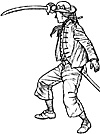 9. Pillage:
9. Pillage:
In order to pillage, a pirate must spend at least one whole turn pillaging. This results in the pirate seizing booty, destroying material, or whatever else a pirate might do besides fight. Some scenarios may require more than one turn of pillaging in order to achieve some objective. Usually, pillaging is the most important part of the scenario. It's important to keep in mind that a pirate cannot fight and pillage or move and pillage. Pillaging is an art form and requires the pirates undivided concentration!
10. Morale Checks:
These aren't a major part of a pirate raid, but even so, there were occasions when one side's morale failed. Every 10 figures that are killed, roll a d10 vs the defender's d10. A tie or higher for the side making the morale check and that side passes. If the side making the morale check rolls lower, the difference in the die is the number of figures that run away/return to the ship. Select figures arbitrarily (those closest to the greatest losses, first…)
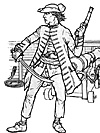 11. Scenario: Supply Raid
11. Scenario: Supply Raid
A. Pirate Schooner with 40 raiders aboard (20 cutlasses, 10 knives, 5 clubs, and 5 pistols). One personality figure – Black Coat (he is one of the forty and carries a cutlass). Pirate cards are A,A,2,2,3,3,4,4.
B. Townsfolk and local police. 25 townsfolk (20 clubs and 5 knives) and 5 police (4 rifles and 1 pistol). One personality figure, the Captain of the Watch (carrying the pistol). Townsfolk/Police cards are A,A,2,2,3,4.
C. Referring to the map, the pirates must reach warehouse 1, pillage it, and return to the ship with the booty. Since this booty is heavy water barrels and food sacks, movement is halved for the returning pirates. The pirates must make it back to their ship in less than 30 turns in order to win (and escape before the militia is called up).
12. Card Deck Equivalents.
| Number of Figures | Cards |
|---|---|
| 10 | A,2,2 |
| 11,12 | A,A,2,2 |
| 13,14 | A,A,2,3 |
| 15,16 | A,A,3,3 |
| 17,18 | A,A,2,2,3 |
| 19,20 | A,A,2,3,3 |
| 21,22 | A,A,2,3,4 |
| 23,24 | A,A,2,2,3,3 |
| 25,26 | A,A,2,2,3,4 |
| 27,28 | A,A,2,3,3,4 |
| 29,30 | A,A,2,3,4,4 |
| 31,32 | A,A,2,2,3,3,4 |
| 33,34 | A,A,2,2,3,4,4 |
| 35,36 | A,A,2,2,3,4,5 |
| 37,38 | A,A,2,2,4,4,5 |
| 39,40 | A,A,2,2,3,3,4,4 |
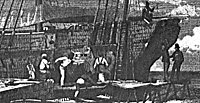 Pirates! designer's notes
Pirates! designer's notes
The method of determining action (by small band or individual) is designed to replicate the roving bands of pillaging pirates (or scared townsfolk). There were those pirates who were complete individuals and thrilled in pillaging. They went in alone because of their confidence and ability. More often though, individual pirates were not so brave and attacked in groups of various sizes. This also will cause the players to ensure they initially move/activate their groups in the sizes they will need to support the scenario's objectives. For example, in the Supply Raid scenario, the pirate player must get at least 15 of his boys to the warehouse. He should probably use the 3 or 4 largest group cards (2,3,3,4,4) to bundle the pirates as they move down the wharf to the warehouse.
This means that the pirates who won't go to the warehouse and who will be providing flank support or additional pillaging will probably be smaller groups (unless you want to take two full turns to move all the pirates). Being this deliberate may prevent the pirate player from achieving his objective in time. A reason why only half the figures can act each turn is to compress time. When individual raiding goes on, figures take stock of their individual situations and won't necessarily act every turn. This replicates the loss of command and control of blood thirsty raiders, trading of insults, eyeing of buxom wenches, the shock of townsfolk as they are attacked, etc.
In certain special circumstances, a scenario designer (and/or gamemaster) may include extra cards to replicate a much better trained/activated situation. For example, in Supply Raid, if the gamemaster wants to change the townsfolk to all militia who are expecting the attack, the gamemaster could use two decks in order to activate every one of the townsfolk during a single turn. I would only keep the extra cards in the action deck for 1 or 2 turns. Then, as command and control breaks down, the individual/group concept takes over. The same thing could be done for the pirates on the first turn if their leader is especially charismatic in whipping them into an attack fervor.
You can also see from the attack dice that a single civilian won't be able to kill a personality figure. Of course not! Gang up on the pirates. Let them isolate themselves as they run rampant throught the town. Then attack them with bunches of people. The hits will add up. Look at the scenario objectives and decide how you need to deploy your forces. Get your figures into the fray with a plan in mind otherwise you'll never get enough of the cards you need. Concentrate your efforts. Keep in mind that the most important point is to have fun. Enjoy!
Back to The Gauntlet No. 12 Table of Contents
Back to The Gauntlet List of Issues
Back to Master Magazine List
© Copyright 1998 by Craig Martelle Publications
This article appears in MagWeb (Magazine Web) on the Internet World Wide Web.
Other military history articles and gaming articles are available at http://www.magweb.com